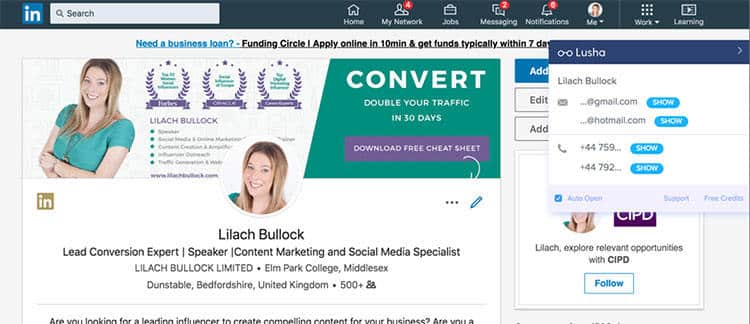Influencer Marketing Mistakes And How To Overcome Them

Influencer marketing is on the roll right now – well, to be more accurate, that has been the case for the past few years.
It can be extremely effective at promoting your business, boosting brand awareness, and increasing engagement with your target audience.
But it can also go the other way just as easily; a bad campaign could lead to no notable results, or it can even potentially have a damaging effect on your brand.
In this blog post, I’m going to discuss influencer marketing mistakes and show you how to overcome them to help you build better campaigns in the future.
The basics of influencer marketing
In theory, influencer marketing is pretty straightforward:
The first step – you find some awesome social influencers that your target audience likes.
Step 2, you work with them to create some content that gets people to take action.
But, in actuality, influencer marketing is just like any other digital marketing practice – it requires considerable research, a fully-fledged strategy, and continuous optimisation.
So, whether you’re just getting started with influencer marketing or looking to improve your current efforts, read on for some of the most common – and potentially catastrophic – mistakes you can make, to find out how exactly you can overcome them and become a better, more successful marketer:
Mistake no. 1: Where’s your strategy?
You’d be surprised by how many marketers don’t actually have a strategy – in fact, studies show that 49% of organizations don’t have a clearly defined digital marketing strategy. And that, frankly, is a bit scary – for them.
But for those who do take the time to plan and strategize, this presents a wonderful opportunity to stand out from their competitors and gain better results with every new campaign.
It’s easy to forego strategy with some digital marketing tactics – and influencer marketing is no different. After all, why spend countless hours putting together a strategy when you already know what you want to do – for example, working with a specific influencer on a month-long campaign promoting your new product?
It might not seem at first glance that you need a strategy, but the reality is, it will make a huge difference to your success.
You can’t realistically keep growing with one-off campaigns with no strategy behind them. Every penny you spend, every hour you “waste”, should be spent to help you achieve your business objectives.
By putting together a strategy, you can:
- Establish what you want to achieve with your campaign, which will then inform the actual content you create as part of the campaign
- Establish budget, spending, and manpower to not waste any of your resources
- Be prepared for any eventuality
- Know what to measure in order to evaluate your campaigns’ success, learn from it, and use that knowledge to improve future campaigns.
How to overcome this mistake
Always put together a strategy before each of your campaign. That means:
- Establishing your objectives – use this template to set SMART marketing goals; i.e. goals that are specific, measurable, attainable, realistic, and time-bound
- Establishing what your KPIs are so that you can measure your campaigns’ ROI (focus on goals that can be measurable and that you know what KPIs to use)
- Choosing what platforms you want to use for your campaign based on your goals and on your target audience
- Establishing what kinds of influencers you want to work with: highly popular influencers with millions of followers, micro-influencers with under 100k followers, or anything in between
- Establishing what you want to promote and how it will help you achieve your overall business goals
- Finding the right social influencers based on your goals and chosen channels that you want to work with
Mistake no. 2: Focusing on follower numbers
As common as the first mistake is, this might even be more widespread. It makes sense – when you see someone with a huge following, with a relatively similar audience (if you look hard enough), and you have the budget to get them on board, why not try it?
After all, this is a tactic that’s been used for decades – celebrities endorsing products that had nothing to do with them or that just didn’t fit with their overall image.
For example, Symantec’s “Hack is Wack” campaign with Snoop Dogg back in 2010 that is now defined by Urban Dictionary as,
“Snoop dog’s desperate attempt to resist a changing market place by starting a rap competition to write a song about the horrors of file sharing”
The campaign was instantly ridiculed – both by the media and by the fans who used the #snoopnorton hashtag to poke some fun.
Or perhaps you might remember Microsoft’s struggle to compete with Apple by using Seinfeld in a collection of “comedy” ads, together with Bill Gates. The ads were quickly pulled as people were struggling to understand what the message even was, and why you’d even take advice on computers and operating systems from Seinfeld (not that they’re trying to). If you’re curious, watch one of the ads here (you’re likely to get a few chuckles out of it, even if you’re not going to order a computer afterwards).
I could go and on with examples of frankly baffling ads with the strangest choices in celebrity endorsements, but let’s get back to influencer marketing.
The world of influencer marketing is really not that different from advertising. Brands and agencies will often use most of their budgets on the biggest possible celebrity/influencer they can get and hope for the best; after all, working with huge influencers means huge reach and plus, people love these influencers and they have countless fans all over the world.
But just like the ads I talked about earlier, influencer marketing campaigns are very likely to fail – and worse yet, backfire – when all they’re based on is the influencers’ audience size.
How to overcome this challenge
Before working with an influencer, you need to perform a lot of research to establish whether they are the right choice for your campaign.
To put it simply, it’s all about their relevancy and their audience.
The first thing you need to consider is what you want to promote – if you’re promoting running shoes, then an influencer who is training for the marathon would be a great idea. Or if you’re selling makeup, then you’d probably benefit most working with an Instagram beauty influencer. And so on and so forth – but that’s not nearly enough research to determine their relevancy or their actual influence (not just their reach, which is very easy to establish). To use the previous example of promoting makeup with an Instagram beauty influencer, even if the influencer is highly relevant in terms of content and has a very engaged audience, you’re still going to fail if the influencers’ majority of followers are from completely different countries than where you’re selling your products.
Beyond reach, you should also research the following to establish an influencers’ relevancy:
- Their audience: who exactly follows them and reads their blogs or follows their vlogs and podcasts? What are their ages, their sexes, and where are they located?
- Their content: what kind of content do these influencers create on their channels? Look at their social media presence as well as their blog/vlog/podcast/etc. to understand what kind of content they’re usually posting and to make decision whether their style would work with your brand values and your campaign objectives
- Their shares: influencers are often expert content curators. People will follow them to get relevant news, tips, and so on. This helps you understand more of the type of content the influencer and their audience prefers and what generates the most engagement. You can use an influencer research tool like Buzzsumo to search for influencers based on the content they share, as well as to see a list of an influencers’ recent shares:
It’s not just relevancy that you need to look into, but also their actual influence; that is because huge follower numbers don’t necessarily mean actual influence – it’s easy to buy followers or even gain a lot of followers without buying them with a proper strategy. However, their followers might be completely irrelevant to your audience and have little interest in the “influencer”. Here’s what to look for:
- Their past campaigns: what other brands have they worked with in the past? What types of products/services have they promoted? Are they the types of products and service that your target audience would use? Use this opportunity to evaluate the different campaigns’ success to better understand their influence: how many shares did their sponsored and branded posts get? What kind of engagement did they receive? The more successful their campaigns with brands, the more likely it is that they hold real influence over their audience and that a good campaign can succeed
- Their engagement: both on their social media channels and any other digital channel they’re using (their blog, vlog, podcast, tumblr, and so on). A high engagement rate means that their fans are actually actively following their posts and are truly interested in them – enough that they will take the time to take some sort of action. And that, at the end of the day, is real influence. The idea is to go for influencers that have high engagement rates on their primary channels – lots of shares of their content, comments on their social media and blogs, likes, and so on. However, it’s important to consider these numbers and stats proportionately with their follower numbers; for example, 500 likes and 30 comments is extremely impressive when the influencer only has 10k followers, but the numbers won’t be nearly as impressive when the influencer has a million followers.
Use these guidelines every time you research a new influencer in order to find the best possible option – and most importantly, forget about follower numbers and reach because in this case, these are just vanity metrics that really don’t mean much at the end of the day (at the very least, not nearly as much as their relevancy and influence).
Mistake no. 3: A poor influencer outreach strategy
A great influencer won’t work with a brand just because they’re getting paid to do it – they have an image to uphold and their own brand to protect if they want to continue being influencers and working with brands.
This is a mistake that many brands make when reaching out to influencers; they will often use similar emails to reach out to multiple influencers, barely take the time to get to know them, and barely personalize their outreach.
This will not only result in poor response rates from your outreach, but it will also hinder your campaigns’ success.
When you have a great relationship with the influencer you’re working with and they’re loving your brand and products, chances are it will result in a much better and much more effective campaign.
How to overcome this challenge
The first step is to research the influencer – as I mentioned before. You’ll get to learn about them and their likes and dislikes, as well as their content, so that you can properly personalize your outreach emails when the time comes.
However, for an even better chance of getting an influencer to work with you and to build an amazing campaign with them, you should also take the time to engage with them:
- Follow them on social media
- Like their posts and share them with your audience (and include a few words about the post when sharing too)
- Leave comments on their blog
- Try to engage in conversations with them via social media
This way, once you do reach out to them with your proposal, the influencer will already be familiar with you.
When it’s time to reach out, you should (preferably) use their direct email instead of social media direct messages or using their contact form and so on.
Some influencer outreach tools will also pull up their email address; if that isn’t the case, you can use an email finder like Lusha to get their direct contact information (both email and phone number):
Lusha works with Twitter and LinkedIn and once you’ve created your account and installed the Lusha Chrome extension, you’ll be able to see the contact information whenever you visit their profiles.
Take your time when writing these outreach emails to show your knowledge of the influencer, as well as your appreciation of their work, and to give them an idea of what you want to achieve by working with them – and show them how this campaign will benefit them beyond their pay check.
Conclusion
Influencer marketing campaigns can generate amazing results for your business, but you need to follow certain steps in order to achieve these results:
- Always put together a detailed strategy
- Choose the right influencers to work with based on their relevancy and actual influence, and not just their reach/follower numbers
- Establish a real connection and relationship with the influencers you work with
What mistakes have you made when working with social influencers?
Add CEOWORLD magazine to your Google News feed.
Follow CEOWORLD magazine headlines on: Google News, LinkedIn, Twitter, and Facebook.
Copyright 2024 The CEOWORLD magazine. All rights reserved. This material (and any extract from it) must not be copied, redistributed or placed on any website, without CEOWORLD magazine' prior written consent. For media queries, please contact: info@ceoworld.biz









